
Saint Emilianus of Trevi (Italian : Emiliano di Trevi), sometimes [1] known as Miliano (died 304), was a 4th-century bishop of Trevi, martyred under Diocletian.

Saint Emilianus of Trevi (Italian : Emiliano di Trevi), sometimes [1] known as Miliano (died 304), was a 4th-century bishop of Trevi, martyred under Diocletian.
An account of his life is given in the Passio Sancti Miliani. [2]
Emilianus came to Spoleto from Armenia at the end of the 3rd century. He was consecrated bishop by Pope Marcellinus and sent to Trevi.
Under the Persecution of Diocletian he was subjected to innumerable tortures and was eventually put to death on 28 January 304 together with three companions. He was decapitated three kilometres from Trevi, at Bovara, then a pagan holy place, bound to an olive tree (which is said still to exist).
Emilianus is the patron of Trevi, of which he was the first bishop. The relics had been forgotten (possibly stolen or hidden during the Middle Ages) but were rediscovered in 1660 during restoration work on Spoleto Cathedral, where they are still preserved.
His feast day is 28 January. The celebrations, going back to remote antiquity, were formerly very solemn, comprising many different events both sacred and secular, of which the most important is the striking nocturnal procession, the Processione dell’Illuminata, held on the evening of the vigil of the feast (27 January). [3]
The saint is also venerated at Ripa in Perugia where his feast in celebrated on the Sunday closest to 28 January.

Pope Marcellinus was the bishop of Rome from 30 June 296 to his death in 304. A historical accusation was levelled at him by some sources to the effect that he might have renounced Christianity during Emperor Diocletian's persecution of Christians before repenting afterwards, which would explain why he is omitted from lists of martyrs. The accusation is rejected, among others, by Augustine of Hippo. He is today venerated as a saint in the Catholic Church and in the Serbian Orthodox Church.
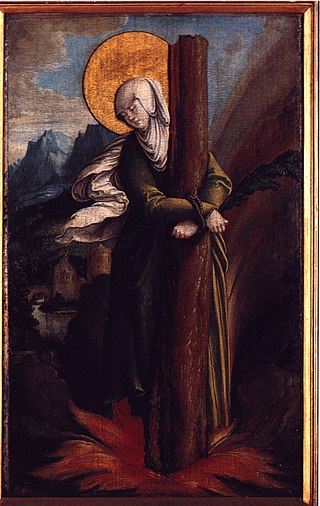
Saint Afra was martyred during the Diocletian persecution. Along with Saint Ulrich & St Simpert, she is a patron saint of Augsburg. Her feast day is August 7. Afra was dedicated to the service of the goddess Venus by her mother, Hilaria. Through his teachings, Bishop Narcissus converted Afra and her family to Christianity. When it was learned that Afra was a Christian, she was brought before Diocletian and ordered to sacrifice to the pagan gods. She refused and was condemned to death by fire.

Spoleto is an ancient city in the Italian province of Perugia in east-central Umbria on a foothill of the Apennines. It is 20 km (12 mi) south of Trevi, 29 km (18 mi) north of Terni, 63 km (39 mi) southeast of Perugia; 212 km (132 mi) southeast of Florence; and 126 km (78 mi) north of Rome.

Vincent of Saragossa, the Protomartyr of Spain, was a deacon of the Church of Saragossa. He is the patron saint of Lisbon, Algarve, and Valencia. His feast day is 22 January in the Catholic Church, Anglican Communion, and the Eastern Orthodox Church, with an additional commemoration on 11 November in the Eastern Orthodox Church. He was born at Huesca and martyred under the Emperor Diocletian around the year 304.

Januarius, also known as Januarius I of Benevento, was Bishop of Benevento and is a martyr and saint of the Catholic Church and the Eastern Orthodox Church. While no contemporary sources on his life are preserved, later sources and legends claim that he died during the Great Persecution, which ended with Diocletian's retirement in 305.
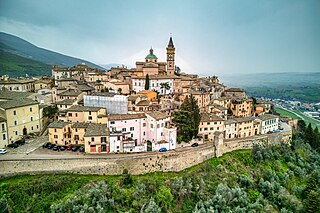
Trevi is an ancient town and comune (municipality) in Umbria, Italy, on the lower flank of Mount Serano overlooking the wide plain of the Clitunno river system. Located in the Province of Perugia, it is 10 km (6 mi) SSE of Foligno and 20 km (12 mi) north of Spoleto. It is one of I Borghi più belli d'Italia.

Pancras was a Roman citizen who converted to Christianity and was beheaded for his faith at the age of fourteen, around the year 304. His name is Greek, meaning 'all-powerful'.
Cyriacus, sometimes Anglicized as Cyriac, according to Christian tradition, is a Christian martyr who was killed in the Diocletianic Persecution. He is one of twenty-seven saints, most of them martyrs, who bear this name, of whom only seven are honoured by a specific mention of their names in the Roman Martyrology.
Durastante Tommaso Francesco Emiliano Natalucci was an Italian historian who specialized in history of Trevi, in Umbria.

Spoleto Cathedral is the cathedral of the Archdiocese of Spoleto-Norcia created in 1821, previously that of the diocese of Spoleto, and the principal church of the Umbrian city of Spoleto, in Italy. It is dedicated to the Assumption of the Blessed Virgin Mary.

Nabor and Felix were Christian martyrs thought to have been killed during the Great Persecution under the Roman emperor Diocletian. A tomb in Milan is believed to contain their relics.

Saints Cyrus and John are venerated as martyrs. They are especially venerated by the Coptic Church and surnamed Wonderworking Unmercenaries because they healed the sick free of charge.
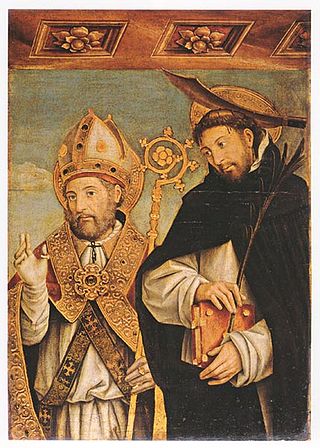
Evasius is believed to have been a missionary and bishop of Asti, in north-west Italy. He was forced to flee to the great Padan forest known as the Selva Cornea, where he and numerous followers were beheaded by pagan, or alternatively by Arian enemies, in the area of what is now Casale Monferrato. He is venerated as a saint of the Roman Catholic Church and is the patron of a number of towns in Piedmont and Lombardy. His cult is liveliest at Casale, where his remains are conserved in the cathedral dedicated to him.

Maternus was Archbishop of Milan from c. 316 to c. 328. He is honoured as a Saint in the Catholic Church and his feast day is on July 18.

Felician(us) of Foligno is the patron saint of Foligno.
Trofimena is a female saint canonised in the Roman Catholic Church. Originally from the town of Patti in Sicily, the relics of Trofimena are venerated in the basilica in the town of Minori, Italy on the coast of Amalfi, southern Italy.
Pontianus was a second century Christian martyr. He was martyred during the reign of the Emperor Marcus Aurelius. He is honored as a saint and martyr by the Catholic Church, the Old Catholic Church, and the Eastern Orthodox Church. In Spoleto, Italy, he is invoked for protection against earthquakes.
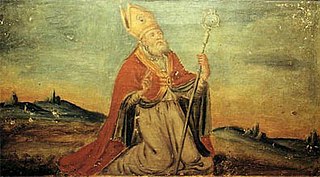
Saint Leucius was initially a missionary from Alexandria, Egypt, who later founded the Diocese of Brindisi, as the first Bishop in 165. It is believed that he later suffered martyrdom in 180.

Mirocles was Bishop of Milan from before 313 to c. 316. He is honoured as a Saint in the Catholic Church and his feast day is on December 3.
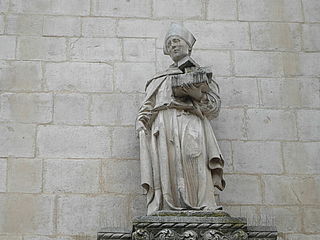
Pamphilus of Sulmona was bishop of Sulmona and Corfinio (Valva) during the late 7th century. He is revered as a saint by the Catholic Church and the Eastern Orthodox Church.